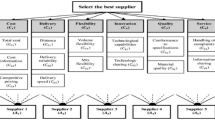Abstract
The aim of this paper is to develop a new fuzzy closeness (FC) methodology for multi-attribute decision making (MADM) in fuzzy environments, which is an important research field in decision science and operations research. The TOPSIS method based on an aggregating function representing “closeness to the ideal solution” is one of the well-known MADM methods. However, while the highest ranked alternative by the TOPSIS method is the best in terms of its ranking index, this does not mean that it is always the closest to the ideal solution. Furthermore, the TOPSIS method presumes crisp data while fuzziness is inherent in decision data and decision making processes, so that fuzzy ratings using linguistic variables are better suited for assessing decision alternatives. In this paper, a new FC method for MADM under fuzzy environments is developed by introducing a multi-attribute ranking index based on the particular measure of closeness to the ideal solution, which is developed from the fuzzy weighted Minkowski distance used as an aggregating function in a compromise programming method. The FC method of compromise ranking determines a compromise solution, providing a maximum “group utility” for the “majority” and a minimum individual regret for the “opponent”. A real example of a personnel selection problem is examined to demonstrate the implementation process of the method proposed in this paper.
Similar content being viewed by others
Explore related subjects
Discover the latest articles, news and stories from top researchers in related subjects.References
Carlsson C., Fuller R. (2000). Multiobjective linguistic optimization. Fuzzy Sets and Systems 115, 5–10
Chen C.T. (2000). Extensions of the TOPSIS for group decision-making under fuzzy environment. Fuzzy Sets and Systems 114, 1–9
Chen S.J., Hwang C.L. (1992). Fuzzy multiple attribute decision making: Methods and applications. Berlin, Springer-Verlag
Chen L.H., Lu H.W. (2001). An approximate approach for ranking fuzzy numbers based on left and right dominance. Computers and Mathematics with Applications 41, 1589–1602
Cheng C.H. (1998). A new approach for ranking fuzzy numbers by distance method. Fuzzy Sets and Systems 95, 307–317
Choobineh F., Huishen L. (1993). An index for ordering fuzzy numbers. Fuzzy Sets and Systems 54, 287–294
Deng H., Yeh C.H., Willis R.J. (2000). Inter-company comparison using modified TOPSIS with objective weights. Computers & Operations Research 27, 963–973
Hwang C.L., Yoon K. (1981). Multiple attributes decision making methods and applications. Berlin Heidelberg, Springer
Lai Y.J., Liu T.Y., Hwang C.L. (1994). TOPSIS for MODM. European Journal of Operational Research 76, 486–500
Li D.-F. (2005a). Multiattribute decision making models and methods using intuitionistic fuzzy sets. Journal of Computer and System Science 70, 73–85
Li D.-F. (2005b). An approach to fuzzy multiattribute decision making under uncertainty. Information Sciences 169, 97–112
Li D.-F, Yang J.-B. (2004). Fuzzy linear programming technique for multiattribute group decision making in fuzzy environments. Information Sciences 158, 263–275
Opricovic S., Tzeng G.-H. (2004). Compromise solution by MCDM methods. European Journal of Operational Research 156, 445–455
Author information
Authors and Affiliations
Corresponding author
Rights and permissions
About this article
Cite this article
Li, D.F. A fuzzy closeness approach to fuzzy multi-attribute decision making. Fuzzy Optim Decis Making 6, 237–254 (2007). https://doi.org/10.1007/s10700-007-9010-1
Published:
Issue Date:
DOI: https://doi.org/10.1007/s10700-007-9010-1




